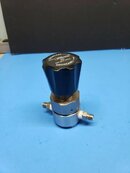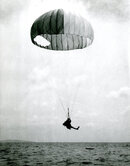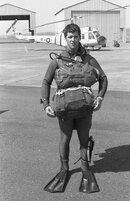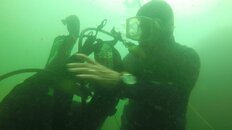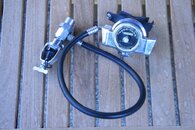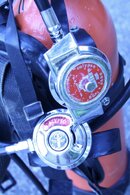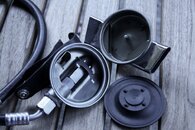You are using an out of date browser. It may not display this or other websites correctly.
You should upgrade or use an alternative browser.
You should upgrade or use an alternative browser.
Single vs two-hose image questions?
- Thread starter Mekotronix
- Start date
Please register or login
Welcome to ScubaBoard, the world's largest scuba diving community. Registration is not required to read the forums, but we encourage you to join. Joining has its benefits and enables you to participate in the discussions.
Benefits of registering include
- Ability to post and comment on topics and discussions.
- A Free photo gallery to share your dive photos with the world.
- You can make this box go away
Thanks for the info,
Ports seem quite small, but you have 30 psi differential, that makes a big difference,,, (thinking about rebreather plumbing)
That image is of a hand-loader. This is the link to the dome-loader with 1/2" ports. Bell exhaust bypassed the BPR in the bell for the divers.
Now, I have three questions concerning mushroom valves.I agree that the perceived Work of Breathing is important to some inexperience divers, but the perceived WOB is not just important for beginner divers. It is very important for experienced Navy divers, for technical diver, and for all recreational divers. It is what the Navy measures with the test setup that I have witnessed and as far as I have seen it is also what it is measured in the dive labs all over.
For the benefit of others, let me clarify that perceived WOB is not something imaginary or that our senses are getting fooled or anything like that.
In human engineering it is well known that our human perception is extremely important, but we are not a measuring instrument. Therefore, we have to design equipment to fit the human, not adapt or train the human to fit the equipment.
Our interface to the world is what we perceive. For example, we think we can measure temperature, but we don’t. What we actually feel is, if something is hot or cold, relative to our warm skin temperature. You can touch a bar of soap and a bar of aluminum. The aluminum will feel colder even if they are at the same temperature. We humans, measure heat transfer not temperature.
As I mentioned, the test dummy used at NEDU look like the torso of a “crash test dummy” and it is instrumented on the back of the throat, as I mentioned on my previous post. I can guaranty you that the Navy is not spending a lot of money, time, and effort just for the comfort level of a beginner diver.
About the subject of exhaust mushroom valves, it is not just the size of the valves that matter. There have been a lot of work and design improvements on mushroom valves. A lot of it may seem like small changes and the casual observer could not tell much of a difference by their looks.
Some of you will remember the old flat exhaust valves. The geometry was just a flat disc and their stiffness was mostly driven by material thickness and material properties, softer rubber softer valves.
Take a closer look at some of the modern mushroom valves. They are not the same and the geometry from one to the next is very different. Some have spokes; some have a circumferential kink at different radiuses and with different angle of kink. The material thickness is often not uniform anymore.
One important thing all the new mushroom valves seem to have in common is that they only touch and seal on the outer perimeter of the valve. There are lifted away from any supporting (wagon wheel) structure to avoid the water surface tension.
I have seen the computer FEA (Finite Element Analysis) models on some of this modern valves and the engineering development is very impressive. The geometrical structure of the valves allows for intended elastic buckling to open up, not just elastic flexing.
To the casual observer it is not at obvious the amount of work and development that has taken place over the years on what we consider a “simple mushroom valve”.
The modern mushroom valve has very close to zero (not measurable) initial opening effort (unless it is sticking due to dirt). And the valve itself tends to move out of the way with flow. The flow resistance is mostly a function of the open area.
This valves are used in many applications (not just Scuba), but again the rebreather need has driven some of the technology (at least for Scuba).
One of the things that impressed me the most was the level of detail in the FEA model and engineering detail for a “simple mushroom valve”. The model was way more involved and sophisticated than some of the FEA we did 40 years ago for spaced deployed equipment (including some parts in the Hubble Optical telescope). Times have change…
--I saw the NEDU (Naval Experimental Diving Unit) writeup on the second generation Calypso regulator. They recommended that the exhaust mushroom be enlarged, and that it open in air. Apparently, opening mostly in air decreases the exhalation effort, and this allowed the third generation to pass the NEDU tests and be recommended for U.S. Navy operations. We in U.S. Air Force Pararescue had already locally purchased the first and second generations of the Calypso regulators, and used them in our parascuba jumps for rescue efforts and NASA missions.
--The original Calypso had the exhaust mushroom in the diaphragm. We used this regulator, and I have two U.S. Divers Company versions of it (the Professional Aquamatic and the original Calypso), and used the AMF Voit 40 Fathom regulator as a high school kid too (Voits version of the Calypso). Does having the exhaust in the diaphragm decrease breathing resistance for exhalation because the air doesn't have to make a turn (over 90 degrees) to get out of the regulator? Dacor, in its last regulators, also had a diaphragm with the exhaust built in, but larger in diameter. It breaths great and I use it quite often. I had to do a doff and don in open water due to the slippage of my tank out of the backpack, and during that I used the Enduro, and it worked really well.
--I know that you designed the Duckbill Eliminator. How does the work you did on this improve the exhalation of the double hose regulators? (I am a bit of a skeptic, but from what you've written here, it sound like this mushroom valve is better than the duckbill.)
Thanks, as I'm very open to improvements.
SeaRat
Attachments
Hi John,
I believe the mushroom exhaust valve issues in air versus water had a lot to do with the water surface tension and the valve contact with flat surfaces. That was basically an ancient valve design concern. The new valve geometries have totally eliminated the issue with water surface tension (or reduced to an insignificant level).
The flat valve in the diaphragm of the early Calypso regulator suffers from a lot design issues, not just the size (small diameter). That flat design is not used anymore on any high performance application for a number of reasons. I can get into a lot more details on this subject, but it is late.
The flow impedance losses due to 90 degree turns are classified in fluid dynamics as secondary or minor losses and are totally dependent on Reynolds number. A 90 degree turn is a big deal in ductwork for HVAC (heating ventilation and air conditioning), but it is not that critical in a lot of other applications. In many applications 90 degree flow turns have very low losses (very low flow impedance, basically insignificant).
Flow constrictions are always a much bigger concern.
I have over 40 years experience doing fluid dynamics analysis… This is a subject that does not need any further debate or discussion. This is an old subject.
I did not design the actual Duckbill Eliminator. That was another engineer friend of ours, but I did collaborate with him.
I did design the case for the Argonaut and I incorporated a well established mushroom valve design for the exhaust valve. There is nothing particularly original in the valve design. From my testing it performs extremely well. The flow impedance is very low.
I have published test results of a variety of different exhausts. My side by side comparison using Reynolds number scaling (to try to simulate higher air density) showed some interesting results. If I recall correctly, the silicone duckbill was almost as good as the some of the modern mushroom valves. But the more traditional duckbills fell short at high flow rates. The results would make sense due to the constriction. The high flow rates was used for the Reynolds number scaling, that I used to predict gas density change at depth.
The duckbills can also suffer from stiction and the surface tension created by the water between the flat surfaces. The flat surfaces can sometimes even tend to stick together. That is one of the reasons why modern mushroom valves only touch with a small edge just around the sealing edge on the perimeter.
Years ago I redesigned the spokes of the vintage mouthpiece wagon wheels to make them into a diamond cross section with no flat surface to contact the "vintage flat mushroom valve". A lot of divers thought I did that to reduce flow impedance since it looks very streamlined (but that was totally secondary). The big reason for the improvement was to reduce or eliminate surface tension and stiction. At the time it was a great improvement.
Since then, we are now using modern umbrella type mushroom valve that avoid unnecessary contact, so my original improvements are not as critical anymore, but the wagon wheel spokes are still more streamlined.
Added:
The design of the Argonaut exhaust uses a typical modern umbrella style mushroom valve. What I did do to improve performance is that I designed the ductwork in the horn leading to the exhaust with the minimum possible flow redistricting. Primarily, I reduced the amount of constriction (also known as restriction) to the minimum possible within the space available.
I also made a very gentle round-to-square transition. But, transition (such as this round-to-square) also falls under the category of secondary (or minor) flow impedance (similar to some elbows).
The plastic molded cans allowed for a lot of design freedom not possible with the metal cans. The design of the horns in the metal cans was very restricted by fabrication limitations. The rectangle fitting of the horns had to be brazed into the metal cans and that drove the design interface of the joint.
They did a great job (probably the best they could) in designing the metal attachment of the round horns to the can edge. They did a beautiful round-to-square transition, but the rectangle is a substantial constriction (anyone can easily calculate the area of the round horn versus the rectangular section).
I am not criticizing; they did a great design and fabrication job with what they had. We now have different tools and new different limitations.
I believe the mushroom exhaust valve issues in air versus water had a lot to do with the water surface tension and the valve contact with flat surfaces. That was basically an ancient valve design concern. The new valve geometries have totally eliminated the issue with water surface tension (or reduced to an insignificant level).
The flat valve in the diaphragm of the early Calypso regulator suffers from a lot design issues, not just the size (small diameter). That flat design is not used anymore on any high performance application for a number of reasons. I can get into a lot more details on this subject, but it is late.
The flow impedance losses due to 90 degree turns are classified in fluid dynamics as secondary or minor losses and are totally dependent on Reynolds number. A 90 degree turn is a big deal in ductwork for HVAC (heating ventilation and air conditioning), but it is not that critical in a lot of other applications. In many applications 90 degree flow turns have very low losses (very low flow impedance, basically insignificant).
Flow constrictions are always a much bigger concern.
I have over 40 years experience doing fluid dynamics analysis… This is a subject that does not need any further debate or discussion. This is an old subject.
I did not design the actual Duckbill Eliminator. That was another engineer friend of ours, but I did collaborate with him.
I did design the case for the Argonaut and I incorporated a well established mushroom valve design for the exhaust valve. There is nothing particularly original in the valve design. From my testing it performs extremely well. The flow impedance is very low.
I have published test results of a variety of different exhausts. My side by side comparison using Reynolds number scaling (to try to simulate higher air density) showed some interesting results. If I recall correctly, the silicone duckbill was almost as good as the some of the modern mushroom valves. But the more traditional duckbills fell short at high flow rates. The results would make sense due to the constriction. The high flow rates was used for the Reynolds number scaling, that I used to predict gas density change at depth.
The duckbills can also suffer from stiction and the surface tension created by the water between the flat surfaces. The flat surfaces can sometimes even tend to stick together. That is one of the reasons why modern mushroom valves only touch with a small edge just around the sealing edge on the perimeter.
Years ago I redesigned the spokes of the vintage mouthpiece wagon wheels to make them into a diamond cross section with no flat surface to contact the "vintage flat mushroom valve". A lot of divers thought I did that to reduce flow impedance since it looks very streamlined (but that was totally secondary). The big reason for the improvement was to reduce or eliminate surface tension and stiction. At the time it was a great improvement.
Since then, we are now using modern umbrella type mushroom valve that avoid unnecessary contact, so my original improvements are not as critical anymore, but the wagon wheel spokes are still more streamlined.
Added:
The design of the Argonaut exhaust uses a typical modern umbrella style mushroom valve. What I did do to improve performance is that I designed the ductwork in the horn leading to the exhaust with the minimum possible flow redistricting. Primarily, I reduced the amount of constriction (also known as restriction) to the minimum possible within the space available.
I also made a very gentle round-to-square transition. But, transition (such as this round-to-square) also falls under the category of secondary (or minor) flow impedance (similar to some elbows).
The plastic molded cans allowed for a lot of design freedom not possible with the metal cans. The design of the horns in the metal cans was very restricted by fabrication limitations. The rectangle fitting of the horns had to be brazed into the metal cans and that drove the design interface of the joint.
They did a great job (probably the best they could) in designing the metal attachment of the round horns to the can edge. They did a beautiful round-to-square transition, but the rectangle is a substantial constriction (anyone can easily calculate the area of the round horn versus the rectangular section).
I am not criticizing; they did a great design and fabrication job with what they had. We now have different tools and new different limitations.
Thank you, Luis. One of the obvious problems with the duckbill is its tendency (maybe more than tendency) to deteriorate over time, and its limited life span. I like their breathing characteristics, but the fact that they need replacement fairly often is a downside. I appreciate your discussion of the duckbill's characteristics above.
I think you may have had a hand in the design of the DSV mouthpiece (Dive Surface Valve mouthpiece). I have one now an my Trieste II, and it performs extremely well. The non-returns in that mouthpiece are great. You can see me using the DSV on my Trieste II in this short video on it and another titled "Why You Need To Wear a Lifejacket."
John
I think you may have had a hand in the design of the DSV mouthpiece (Dive Surface Valve mouthpiece). I have one now an my Trieste II, and it performs extremely well. The non-returns in that mouthpiece are great. You can see me using the DSV on my Trieste II in this short video on it and another titled "Why You Need To Wear a Lifejacket."
John
The answer is no and it depends.Does having the exhaust in the diaphragm decrease breathing resistance for exhalation because the air doesn't have to make a turn (over 90 degrees) to get out of the regulator?
SeaRat
The 90 degree turn is of no consequence and I guess it is really closer to 180 degrees in most conventional second stages. The second stage acting as a manifold, the air moving out of it through the exhaust valve is not really turning, just accelerating though the opening in the case and restriction of the mushroom valve. Thus a small increase in diameter greatly increases the effective area and reduces the needed displacement of the valve and reduces the needed acceleration of the air mass for a given volume to pass through and out in the same amount of time.
In the typical swimming positions, the exhaust valve if incorporated into the diaphragm (Scubapro 400 series) would be deeper in the water column than the exhaust valve in a more conventional second stage case (G250) and on that consideration alone would then have a higher exhalation effort needed. For lowest exhaust effort, we would want the exhaust valve at a lesser value than the divers lungs and then resulting more shallow than the demand diaphragm. Which then leads us to second stage case geometry fault considerations. If the exhaust valve is more shallow than the demand diaphragm it can cause free flow, basically this difference in water column between the demand lever and the exhaust valve sets the minimum practical cracking force for the second stage. So, for lowest cracking effort the exhaust valve and demand diaphragm would be at the same water column depth.
Interesting that SP moved the exhaust valve from the possibly more (all around) ideal position located in the center of the demand diaphragm for the reduced cracking effort and zero case fault of the earlier 400 series second stages to the backside of the case introducing case fault geometry to their relative positions to each other. But the exhaust valve being now more shallow results in an easier exhaust effort (in swimming positions). It has been considered that the exhaust effort is as important to WOB or more so than the cracking effort, was this change an attempt to decrease WOB through the entire cycle? SP took a hit on the 420 needing a slightly higher cracking effort than previous coaxial designs but gaining a resulting lower exhaust effort?
As to where the effort of breathing is perceived, I am not sold on the back of the throat or in the throat hypothesis. The Navy may be using that location for some purpose of simplification of instrumentation, I do not know. But what I do know is that I most definitely feel resistance to both inhation in particular but also exhalation in my chest. The lungs may have no feeling, but the efforts of the diaphragm and chest muscles are perceived by the diver, this diver for sure! Engineering is the application of science and in this case possibly a bad application or misunderstanding of an observation of the science being applied regarding the physiology of human breathing. All that said, I sense the WOB in my chest, not in my throat, my hypothesis. A scientist would then perform an experiment. Set up an experiment, have one Wendy's Frosty and one hungry diver sucking on the Frosty. The subject wants to feel and taste the ice cream in his mouth and feel it go down the throat but the effort expended to find that gratification is sensed in the chest or the throat? I guess he needs to install strain gauges to measure the variables and find what values can be constrained to verify the hypothesis or just, do what everyone does these days and go by feelings
James
As to where the effort of breathing is perceived, I am not sold on the back of the throat or in the throat hypothesis. The Navy may be using thta location for some purpose of simplification, I do not know. But what I do know is that I most definitely feel resistance to both inhation in particular but also exhalation in my chest. The lungs may have no feeling, but the efforts of the diaphragm and chest muscles are perceived by the diver, this diver for sure!
James
We all know you are a very unique individual... You probably feel things the rest of us don't even comprehend...
I am just kidding...

For the benefit of others, James is a good friend and dive buddy...
I was not meaning to pick on anyone, especially the US Navy, they might send an "operator" after me! Like picking a fight with the undefeated champ.
I have just been exploring case geometry and and I know it is a variable but it is just that, variable, because a diver's postion is not static but dynamic and ever changing. I guess that I am not certain that case fault is such a big thing. But a coaxial design would seem best, maybe, but more complicated to execute?
Or just dive Kraken double hose!
James
I have just been exploring case geometry and and I know it is a variable but it is just that, variable, because a diver's postion is not static but dynamic and ever changing. I guess that I am not certain that case fault is such a big thing. But a coaxial design would seem best, maybe, but more complicated to execute?
Or just dive Kraken double hose!
James
When I was younger, and I mean a lot younger (in my teens) I used to be able to free dive to what we considered fairly deep at the time, over 60 feet… At that depth our lungs would be compressed to 1/3 of our surface volume. I never felt any pressure differential on my lungs (but I my ears had to equalize all the way down).
You probably met free diver Robert Croft (US Navy) free dive to 240 feet in 1968 for Navy test. His lungs didn’t collapse and he felt nothing.
They free dive now-a-days to hundreds of feet and they never mention any feeling of pressure on the lungs… But we all have to equalize our ears even at the first few feet of pressure/ depth.
Below we have some very rough diagrams showing a diver and proper double hose (DH) regulator positioning.
The first one is the picture that James posted that we should be familiar with. It shows a vertical diver (most likely out of the water) with the tank and regulator in the position we always advertise as correct position between the shoulder blades.

The second diagram (kind of rough) shows a diver in a perfectly horizontal position. Notice that in this position moving the cylinder up or down parallel to the diver’s central axis will not move the regulator up-or-down in the water column.
It doesn’t help to move the cylinder down the back of the divers body if the divers swimming position is perfectly horizontal.
To add “insult to injury” the diver will end up with a pain in the neck from flexing the neck too much to look forward. I tell you how I know: We were in Cozumel 3 weeks ago and I dove a lot (too much) in this horizontal position to keep a low profile in the current… My neck was screaming for several evenings and I was thinking of some tech divers like @tbone1004 who promotes such non-sense.


The third diagram shows the diver in a comfortable 10 degree slope. Notice that he can look forward without over exerting his/ her neck, and just as important notice the vertical position in the water column of the green dot.
The green dot on diagrams 2 and 3 represent the approximate location of the eupneic centroid (the center of pressure differential perception in the human body).
Notice the vertical level (in the water column) of the eupneic centroid in comparison with the level of the DH regulator diaphragm.
This should be a fairly obvious reason of why we wear our DH regulator where we do and why we should normally swim in that position… not just to avoid a pain in the neck!

You probably met free diver Robert Croft (US Navy) free dive to 240 feet in 1968 for Navy test. His lungs didn’t collapse and he felt nothing.
They free dive now-a-days to hundreds of feet and they never mention any feeling of pressure on the lungs… But we all have to equalize our ears even at the first few feet of pressure/ depth.
Below we have some very rough diagrams showing a diver and proper double hose (DH) regulator positioning.
The first one is the picture that James posted that we should be familiar with. It shows a vertical diver (most likely out of the water) with the tank and regulator in the position we always advertise as correct position between the shoulder blades.
The second diagram (kind of rough) shows a diver in a perfectly horizontal position. Notice that in this position moving the cylinder up or down parallel to the diver’s central axis will not move the regulator up-or-down in the water column.
It doesn’t help to move the cylinder down the back of the divers body if the divers swimming position is perfectly horizontal.
To add “insult to injury” the diver will end up with a pain in the neck from flexing the neck too much to look forward. I tell you how I know: We were in Cozumel 3 weeks ago and I dove a lot (too much) in this horizontal position to keep a low profile in the current… My neck was screaming for several evenings and I was thinking of some tech divers like @tbone1004 who promotes such non-sense.

The third diagram shows the diver in a comfortable 10 degree slope. Notice that he can look forward without over exerting his/ her neck, and just as important notice the vertical position in the water column of the green dot.
The green dot on diagrams 2 and 3 represent the approximate location of the eupneic centroid (the center of pressure differential perception in the human body).
Notice the vertical level (in the water column) of the eupneic centroid in comparison with the level of the DH regulator diaphragm.
This should be a fairly obvious reason of why we wear our DH regulator where we do and why we should normally swim in that position… not just to avoid a pain in the neck!
My new to me SP G250 second stages that I have been diving of late have really been impressive as they have a large diaphragm for good mechanical advantage and a very powerful Venturi and the VIVA vane seems very effective. I can see now why it is the most copied, most produced single hose second stage. And the Kraken in my photo is the most advanced dh regulator ever produced even over the AL Mentor (military regulator).
James
[HIJACK]
@Nemrod , if you are impressed by the G250, you owe it to yourself to try a D400. I have a Balanced Adjustable (purchased new in 1987), a G250 (1988), and a D400 (1994). For recreational exposures in temperate or tropical water, the D400 wins, no contest, IMHO!
r7diver
[/HIJACK]
Similar threads
- Replies
- 0
- Views
- 532
- Replies
- 28
- Views
- 7,099
- Replies
- 17
- Views
- 561



